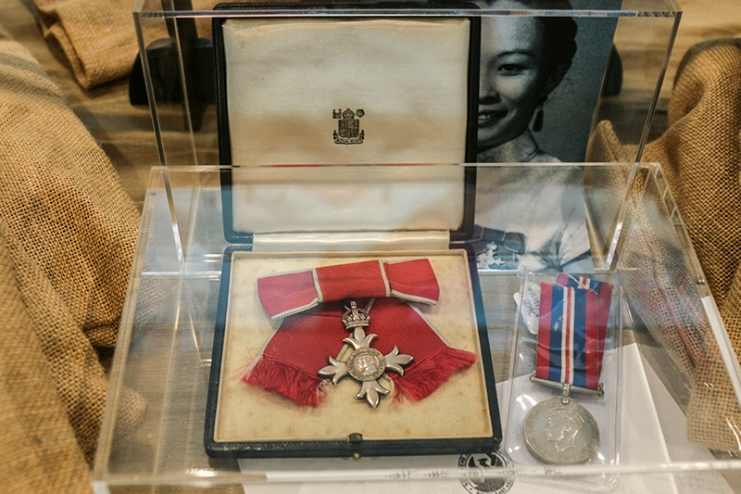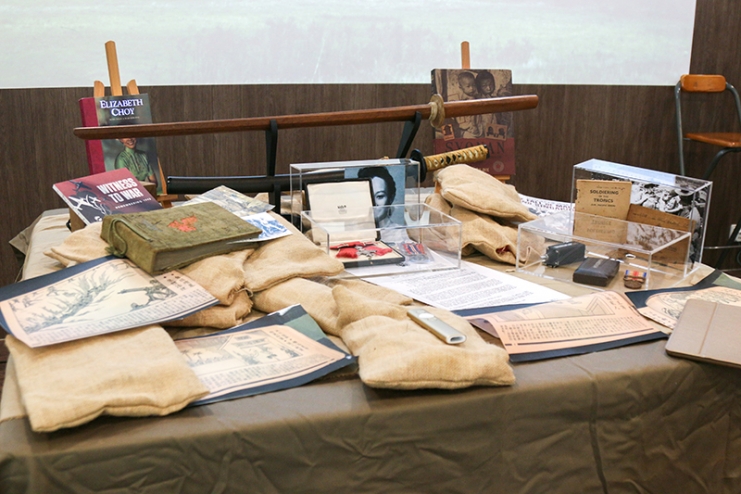An Interview on Elizabeth Choy

On the 75th anniversary of the Fall of Singapore this year (2017), to help survivors of the Second World War find peace with themselves and with the past, Karen Hoisington has been commending the life of her grandaunt Elizabeth Choy. She speaks to The Courier regarding the wartime heroine and how she continues to be an inspiration for women and Christians, and also of Choy’s links to the Cathedral.
The Courier (TC): For the uninitiated, could you introduce the subject of our conversation? Who is Elizabeth Choy?
Karen Hoisington (KH): Elizabeth Choy, who came to Singapore in 1929 from North Borneo, was a decorated WW2 heroine during the Japanese Occupation of Singapore from 1942 to 1945.
During the Occupation, with no work, and needing to survive, both Elizabeth, a school teacher at St Andrew’s School, and her husband, Choy Khun Heng, an accountant at Borneo Company, set up a canteen at Tan Tock Seng Hospital to sell food and basic needs to the hospital staff.
News of their canteen got to Bishop Leonard Wilson, who was Bishop of Singapore at the time. He approached the Choys to help provide quinine and other medicines to the diseased and dying POWS in Changi Prison.
Filled with compassion and Christian charity, the couple agreed to help bring comfort to the 50,000 prisoners-of-war interned in Changi Prison, by passing parcels containing fresh clothing, medicine and letters during the daily ambulance deliveries to the prison. The Choys incurred further risk by sending in radio parts for hidden receivers until a Japanese crackdown in Changi Prison.
They were eventually arrested, imprisoned and subjected to torture. Khun Heng was interned at Outram Prison, while Elizabeth was arrested at the Japanese Military Police or Kempeitai HQ at the YMCA on Orchard Road. For the next 193 days, in a windowless cell no bigger than three by four metres, with only a narrow air-vent on one wall, Elizabeth was subjected to torture, together with her cellmates of twenty people, who were a mix of civil servants, doctors and businessmen. She was spat upon, kicked, stripped, severely beaten and electrocuted daily.
She survived the ordeal by sheer strength of willpower, a moral duty and her strong unflinching faith in God. Elizabeth and Khun Choy received an Order of the British Empire (OBE) in June 1946 for acts of service and valour towards the Allied Forces. Elizabeth was invited to meet with Queen Elizabeth in July, the same year.

Elizabeth passed away in 2006 at the age of 96. Her wake was held at St Andrew’s Cathedral, an honour given for the first time to a parishioner. Singapore ministers and members of society came to pay their respects to a humble yet formidable woman.
TC: What were Choy’s main contributions to Singapore? Are there any particular actions she is especially remembered for?
KH: Invited to recuperate in England by Lady Shenton Thomas, wife of the Singapore governor, Elizabeth returned to Singapore in 1949 and resumed her teaching post at St Andrew’s School. She also became involved in the political developments preceding Singapore’s independence. From 1951 to 1955, Elizabeth served as a Legislative Councillor where she spoke frequently on behalf of the poor and needy, and campaigned for the development of social services and family planning. Elizabeth started the School for the Blind as their first principal, advocating for their right to be educated. Her dedicated service in social work and impressing young Singaporeans with the need to maintain a strong national defence carried on well into her 90s.
Elizabeth would probably like to be remembered in three areas as her contribution to Singapore; (1) campaigning for the development of social services and family planning, especially for the empowerment of women in the 1950s; (2) establishing the School of the Blind for handicapped children to be educated at a time when it was a social stigma; and (3) advocating for national self-defence as a direct result of her war experience when she volunteered for the Singapore Volunteer Forces, a precursor to Singapore’s Armed Forces after the war.
Elizabeth was and is a symbol of the nation’s collective hardship during Japanese Occupation of Singapore, who with courage, resolve and dignity, embodied true faith in times of adversity and persecution.
TC: Do comment on Choy’s life and faith as a Christian. How did her actions and the way she lived speak well of her faith and of her Lord and Saviour?
KH: Elizabeth’s life is a spiritual inspiration for all Christians. So much of what the Apostle Paul wrote in the first chapter of Philippians can describe her life of faith. Elizabeth’s actions in front of her torturers, matching their wits and not flinching, as she walked back with dignity, showed that she knew her identity in Christ.
Elizabeth remembers, “During the torture, it was impossible to show defiance and be brave; it was impossible to suppress the screams, or to stop the tears and mucus from streaming down my face.” Yet, she refused to confess to something she knew was untrue. It would implicate others. Elizabeth would rather endure more physical abuse at the hands of her jailors than betray her people.
By this, she showed the agape love and concern for the welfare of her cell-mates and cared for that more than for her own safety and suffering. Her compassion and selflessness, as well as the fact that she remained undefeated to the end, won her the admiration of both her fellow detainees and her Japanese torturers. The Book of Esther teaches how to put aside our own needs for the needs of others, “if I perish, I perish” (Esther 4:16). Her courage to not plot revenge or hold a grudge of hatred can remind us of how the Lord Jesus also, when persecuted, chose to forgive his enemies.
Elizabeth shone in the corridors and dark recesses of the YMCA cell, demonstrating a life worthy of the gospel and not being afraid of her cruel adversaries, conscious that the Christian faith requires not only to believe in Christ but also to suffer for His sake (Phil 1:27-28). In Elizabeth’s own words, she would want to be remembered the way she lived and spoke well of her faith in Christ, “as someone who loves peace”, upholds the exhortation to “be kind to everybody… the strong helping the weak, the rich helping the poor”.
TC: What are some ways in which women today may draw inspiration from the life and experiences of Choy?
KH: Elizabeth was more than a victim of war or a war survivor. She used her experiences to encourage and empower others rather than hide in shame. Although it took Elizabeth more than 40 years to muster the courage to open painful wounds of the past, she, nevertheless did. A TheatreWorks production entitled “Not Afraid To Remember” was staged in 1986. The director, Lim Siauw Chong, was a student of Elizabeth Choy’s at St. Andrew’s School. He found out about her war experiences while doing research and subsequently pushed for the staging of the production as well as for Elizabeth to continue to share her inspiring story, well after his play about her life. This she did, till her death.

Singapore in the 1950s was a turbulent time in between decolonising and independence from Britain and Malaya respectively. The era witnessed numerous riots (like Maria Hertogh riots of 1950 and the Hock Lee bus riots of 1955), political upheavals and the constitution of the new Republic of Singapore. Elizabeth was chosen as the right symbol for maintaining harmony and continuing links with a multiracial nation. She was the best of East and West being decorated as a war heroine, articulate, educated, and having poise.
At the same time, there were calls for polygamy to be abolished, the right of women to vote, the welfare of children, family planning and the underprivileged. These were important social causes that Elizabeth advocated for as a female legislative councillor. She believed in women’s equality as a stabilising factor in society.
Fast forward, women today can learn important lessons from Elizabeth’s life. She was:
- Pro-active. She found ways to be useful instead of hiding in fear. She volunteered for service as an auxiliary nurse and a gunner in the Singapore Volunteer Forces
- Kept productive. During times of adversity, she served with acts of kindness and compassion to the suffering
- Willing to pay the price. She had to do what was morally right in the eyes of God despite the consequences if caught
- Demonstrated Christian hospitality. She went out of her way to help her neighbours
- Persevered to do good. Friend or foe, she understood why humans do bad things and forgave them as Jesus forgave the sins of man
- Courage under orders. She accepted her torture with strength, resolute and dignity. There was no revenge or malice in her heart. In turn she gained the respect of her torturers who saw her compassion
Considering the current conversation on violence against women, abuse, and harassment of women in the workplace or at home, Elizabeth’s story speaks empowerment and healing into women who are going through violence of any kind. There is bullying in schools and workplaces, abuse at home, and powerlessness even in sophisticated Singapore as it is all around the world today. Elizabeth’s story is timely as it challenges women not to be simply victims or mere survivors but to act in the opposite spirit towards those who persecute them. That of the grace and strength that comes from Christ (Phil 4:13).
TC: Since this interview is for a magazine of St Andrew’s Cathedral, we would love to know what some of the most important links between Choy and the Cathedral were.
KH: First, it can be plainly seen that God was behind all the connections well before the war. After all, He is the Master of our destiny. When Elizabeth and her family arrived from North Borneo to Singapore in 1929, she made St Andrew’s Cathedral her home church. She was awed by its majestic architecture and uplifting spiritual services.
After graduating from Convent of the Holy Infant Jesus, Elizabeth could not enroll into Raffles College (NUS today) due to financial difficulties at the time. So, she took a teaching post at St Andrew’s Boys’ School that was affiliated to St Andrew’s Cathedral. Reverend Reginald Keith Sorby Adams was the school’s principal in 1934 when Elizabeth was there.
Bishop John Leonard Wilson was appointed Bishop of Singapore in 1941 and served at St Andrew’s Cathedral during the time of the Japanese Occupation till 1949. When Singapore surrendered to the Japanese on 15 February 1942, Bishop Wilson, assisted by Reverend Adams of St Andrew’s School, ministered tirelessly to the people of Singapore. Thanks mainly to the help of a Christian Japanese officer Andrew Ogawa, they could continue their ministry till the Japanese saw the growing popularity of the cathedral with its English-speaking congregation as a threat.
Bishop Wilson together with two other ministers were subsequently interned in Changi prison in 1943.
The Bishop was allowed free movement before his arrest by the Japanese and sought the Choys help to send packages of medicine, cash and letters in the daily ambulance runs between their canteen in Tan Tock Seng Hospital and Changi Prison.
When Bishop Wilson and Elizabeth were arrested after a Japanese crackdown at Changi Prison, the bishop was an ever-present source of encouragement through his songs of praise and good cheer. He would serve Holy Communion, made of stale, burnt rice and water from the toilet bowl when Elizabeth walked past his cell after being interrogated or cleaning the corridors.
Therefore, the important links between Elizabeth and the Cathedral are; (1) God’s divine leading to make St Andrew’s her home church all through her life till she passed away; (2) a series of timely connections with Rev Adams and Bishop Wilson to serve the POWs in Changi prison, together, in the service of Christian charity; (3) the close bond between Elizabeth and Bishop Wilson is akin to that between Paul and Silas in the Philippian jail where they sang worship songs, kept up the spirits of their fellow cellmates in good cheer and strengthened each other as brother and sister in Christ, even as they themselves went through physical torture and pain. These accounts embody the true spirit of the church as the Body of Christ.
TC: I understand that you have given talks on Choy at the Cathedral and the National Museum in commemoration of the 75th anniversary of the Fall of Singapore. Did you have any particular objectives in mind when you delivered those lectures? And why is it so vital for us to remember Elizabeth Choy during this notable year?
KH: I knew of how the 75th anniversary of the Fall of Singapore was designated as a year-long season beginning from 15 February this year (2017) with the launch of the Former Ford Factory, to a key exhibition at the National Museum of Singapore titled “Witness to War” and a series of complementary lectures and events that will take place regularly till March 2018.
I felt it was important to seize the opportunity to share the legacy of Elizabeth Choy to a new generation as well as those who know her story yet still seek an unknown fact about her life. As a member of the family, I felt history, if left untold, betrays the life or lives that lived it. I can say it is akin to the gospel. To not share it when an opportunity presents itself, is a denial of what Christ has done for us on the cross.
I felt compelled to share Elizabeth’s story, not from any ambition, but to bring reconciliation of the past in the lives of people who went through the war, to allow context, understanding and forgiveness where there is still pain. I was also motivated to change the conversation from the hatred for the Japanese even today to one that could forgive them. Teaching as an honorary professor at Kyoto International University last year gave me an intimate perspective of the Japanese people and their motivations and beliefs as I worked alongside them. I visited their war shrine to understand their own pain.
Elizabeth was correct to say that the brutal training of the Japanese military made them brutal in turn towards others in war. The Japanese soldiers were simple farmers and coal miners listed for war under harsh conditions which required total compliance to their leaders, who in turn had to answer to the Emperor, then regarded as a god. It was this balance and understanding that Elizabeth also knew that I wanted to convey.
It was a sober undertaking for not only me as a war history researcher, but also my family and therefore personal and emotional. It was truly by the grace of God that I could plough through hundreds of pages on the horrors of war and not be too grieved to give up. It made me reflect on what man can be without Jesus as his Lord and Saviour.

I was conscious of the position of privilege extended to me to honour the legacy of Elizabeth by the National Library, St Andrew’s Cathedral, the National Museum of Singapore and more to come. The talks were not merely about history but those who came felt like family who had fond memories of meeting her in person during her 96 years.
It seemed the objectives were accomplished as new family members came forth to reconnect from afar with current ones like Elizabeth’s daughters, distant cousins and old aunts. They shared their own stories of Elizabeth that were so valuable to the narrative for future generations. The audience were also moved to tears.
The positive feedback from the recent museum talk of nearly a packed auditorium, words like “magnetic”, “drawn”, “authentic”, “humble”, “a feeling of peace and love” can only point to the manifestation of God’s presence among the listeners. As for the museum officials, they noted, never in their history of public lectures did so many linger long after an event is over, connecting and reconciling. As the messenger, I give all glory to God that it was a mission accomplished for the nation of Singapore and for the Kingdom of God.
TC: Karen, you are a relative of Elizabeth Choy. Would you be able to share your personal experiences with your prominent aunt? What was she like and how was she a blessing to her immediate and extended families?
KH: I would like to just share the words of my last living aunt, Theresa Choy. With a faraway look, she simply said, “Elizabeth was the kindest woman I have ever known.” I believe all of us, as immediate family and extended family, echo those same words. Elizabeth was not only a beautiful woman on the outside, clothed with dignity and courage, but more importantly, she was clothed with true compassion, kindness, humility, gentleness and patience, as one of God’s chosen (Col 3:12). These are also the characteristics that we as Christians aspire too, isn’t it?


